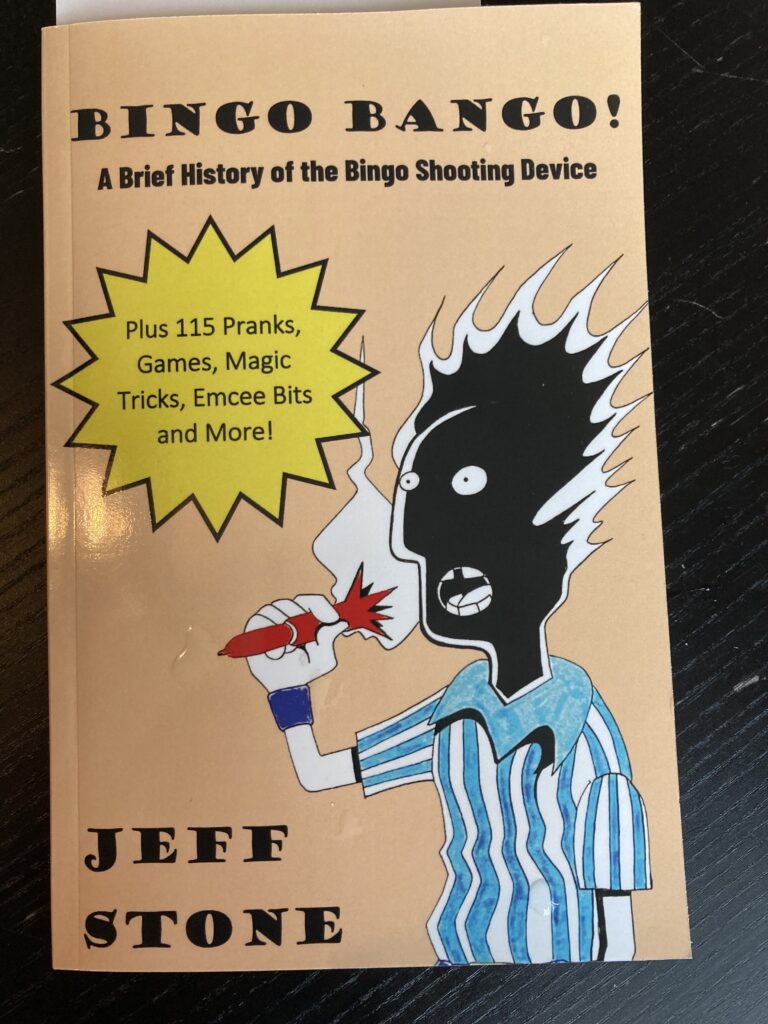It hit me yesterday while I was doing my version of the invisible deck was that my version is not about the card, it’s about the two cards matching. That’s a huge distinction when it comes to making it play big. If you’re performing on stage with the invisible deck, the audience needs to know it’s the card that was named. In my routine since it’s a prediction, they only need to know that the two cards match. That means they only need to be able to tell the cards look the same from the back of the audience.
To make it play bigger, but still use a normal size deck, I have a few options. I could use a jumbo index card, which I personally don’t like. I think they look funny. In the past for stage work, I’ve used GIANT INDEX cards. These are cards that don’t have the pips in the middle, they are more like flash cards. These also look funny, but I like they way the look more than Jumbo index cards. The final option is to use the Phoenix Large Index Cards. These are normal looking cards, but the pips and indexes are 50% larger.
I just ordered some of the large index cards. I’m going to make a gimmicked deck and give it a try when I’m back at the fair on Wednesday. I’m guessing it will play slightly better, I don’t think the difference will be huge, but better than how it’s been.
I also figured out the optimum number of cards to do the trick with. I need to do the trick with 16 pairs (32 total). That’s going to eliminate evenly from 32 to 16 to 8 to 4 to 2 to the final card. I’m hoping that 32 cards will still play like a full deck from the stage. We’ll find out…
-Louie
Month: October 2021
Writing For the Invisible Deck…
As I still keep working on my version of the Invisible Deck, I think I have the technical end worked out. The biggest challenge is the elimination process. I needed to figure out how to remove any confusion as to what side people are selecting. What I have settled on is having people point to a side of the room. If they point to my hands, I can’t tell which side they are pointing at. So having them point at the left or right wall clears that up.
Next up is figuring out the presentation. As I’ve been doing it, as the elimination process happens I’ve organically been saying, “that’s what I would have done”. I’m kinda using that as the base for the routine. Here’s what I wrote last night:
“Whenever I leave the house, my wife tells me to make good choices. I’m gonna tell you, I only make the best choices! Like the time I made my own penicillin from sour cream…or when I knitted my own seatbelt…or the time I went to Wyoming.”
It’s a starting point. Maybe I could say say their “choices are better than the time I…” and then say something funny. I think I’m not at a point where I just need to write and try out the jokes.
More Invisible Deck Work…
One of the tricks I’m working on right now at the fair is my version of the Invisible Deck…Well my version of Vernet’s 52 B’wave. The effect is a selected card is in a second deck face up, has a different colored back and the rest of the deck is blank.
Because of my method for the trick, I know what the selected card it without looking at the face. Yesterday I said the name of the card without looking at it and someone in the audience called me on it. I played it off as saying I did look, and they must not have noticed. I need to do an exaggerated look at the front of the card. I also need to do a streamlined elimination of the cards. Right now I’m splitting the cards in half and eliminating half at each split. I need to figure out the least number of splits. Like maybe doing it with a 45 or 48 card deck instead of a 52 card deck make it go a little bit faster?
I’m figuring out the beats and how to make it play better with the audience. After the first reveal of the card upside down, I’m flipping the card they chose over, saying they aren’t an exact match, as that’s from a blue deck and I’m holding a red deck. I then flip the card in the red deck over to show it has has a red back. The change from just saying, “and it has a different colored back” to explaining why it would have a different colored back is giving me a stronger reaction.
I’m liking how this plays better than the traditional invisible deck where they simply name a card. It involves a lot of people from the audience, and they can see the cards that they are making a choice of. While it’s dirtier than the traditional invisible deck method/effect, it also eliminates the top explanations on how the tricks works:
1. Everyone picks the _____
2. It was set up with the person in advance
While neither of those are how the traditional invisible deck works, you really can’t argue them.
Coins and Confetti…
At my gig this month, I’m really trying to streamline my show and what props I’m lugging around. I have way more stuff than I need in my table. However I also noticed that for the coin trick that I do, the coins right now lay in a stack on my table bin. I think it would be easier to have them in a vertical stack. They’ll take up less space and be easier to grab. I also am playing with a bit where I need to grab some confetti from my case. An easy way would be to have a little holder that attaches to the side of the case.
This is where 3D printing comes in handy. It took me about 5 minutes to design the two holders:
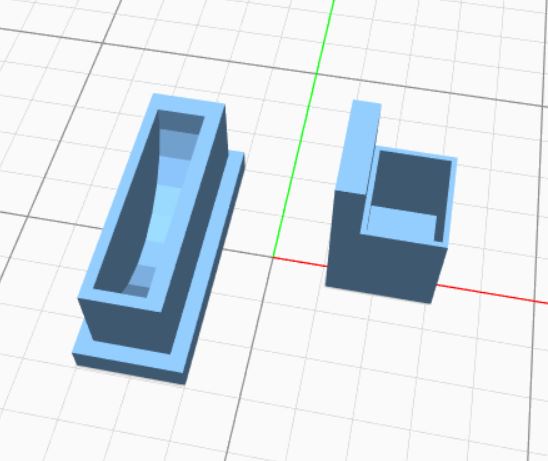
It took about an hour for the two holders to print, and I’m good to go! 5 minutes of active work and here’s what I ended up with:
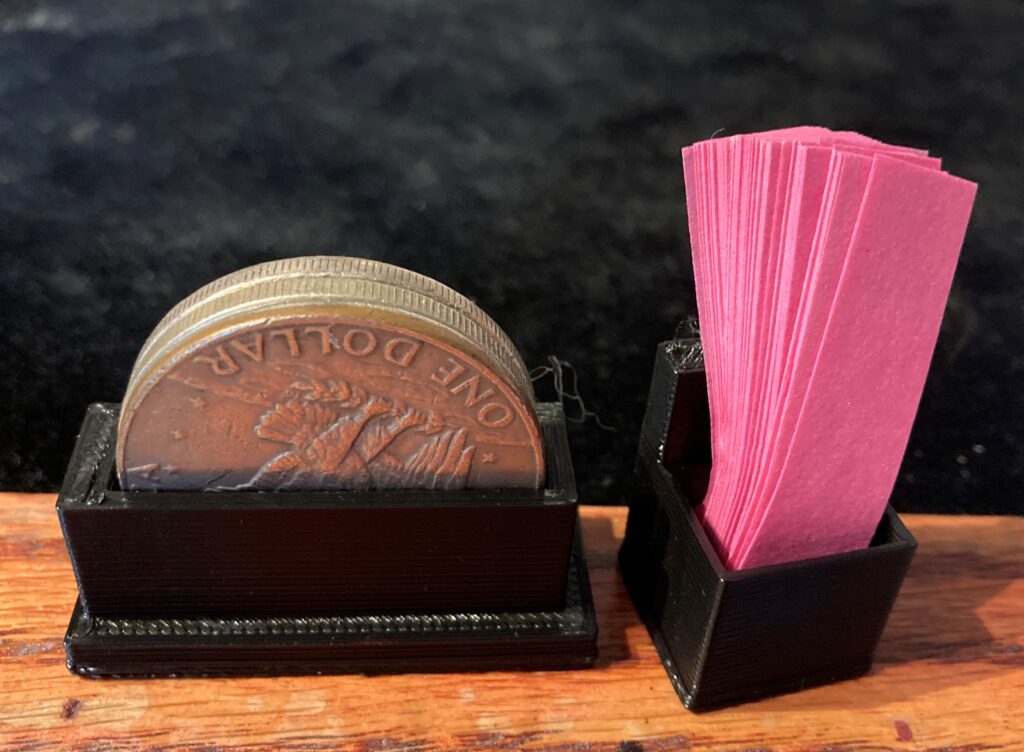
It’s little things like this, that if I had to make from “found materials” it would have taken me more that five minutes to make. This is why I’m such a fan and suggest to everyone that they learn to 3D print!
Bingo!
I’m was home for a day and in the mail that had been accumulating was a book called Bingo Bango by Jeff Stone. It’s a book about the classic practical joke item that makes a loud bang and surprises people.
The book is a fun read and has over 100 things you can do with the Bingo Device. There are jokes, magic tricks, gags and more.
What surprise me was that apparently at some point I had helped Jeff figure out some of the history of the is joke. I know a bit about about, when I used to work at Market Magic Shop in Seattle, I sold a ton of them. They came in many different forms, sometimes hidden in books, or pens, or even on that is held on your hand like a joy buzzer.
It was very sweet of Jeff to send me a book, and he wrote me a nice note as well:
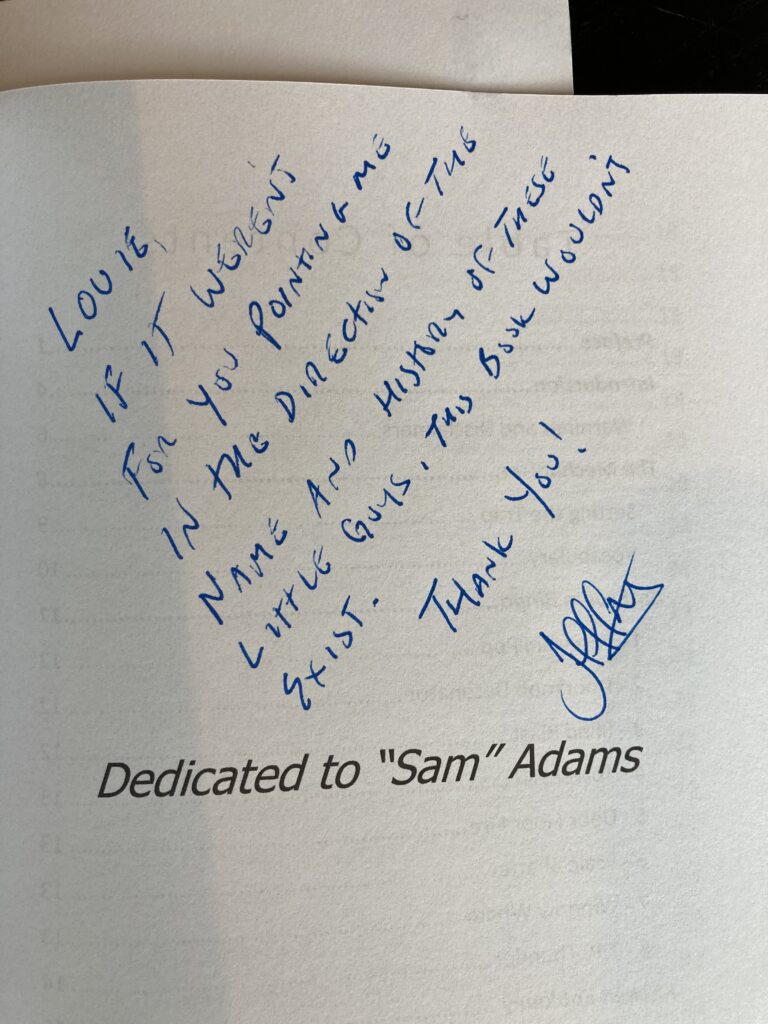
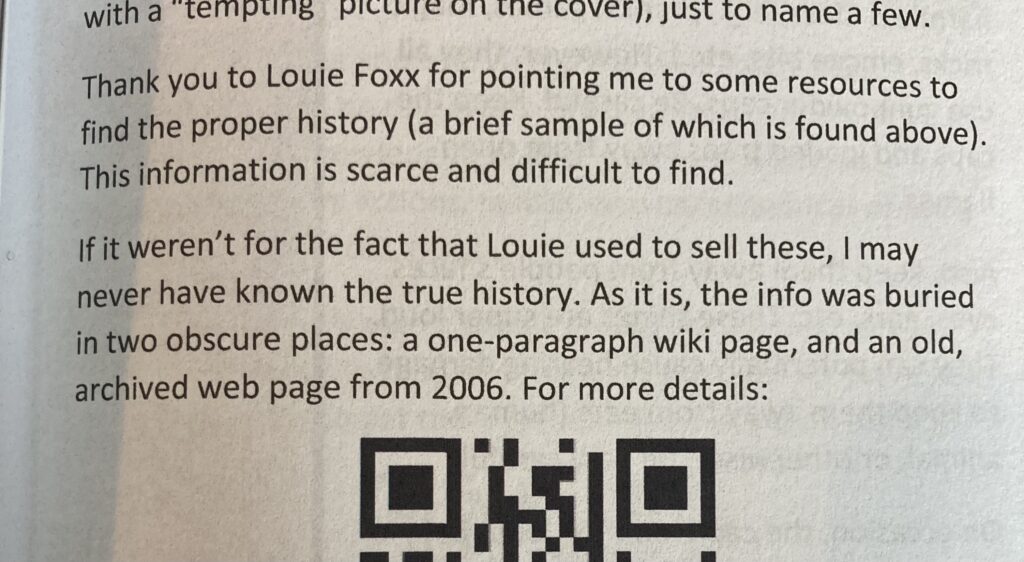
This is a fun book, and if you’re into practical jokes it’s great! Another fun thing about this book is to see how brainstorming on one idea can lead to soo many different ideas!
Trying the Inivisble Deck Plus…
A couple days ago I wrote about an idea I had for a method for the invisible deck, but had a kicker where the card had a different colored back and then the rest of the cards were blank. This was inspired by Vernet Magic’s 52 B’Wave card trick.
I’ve been doing it at the fair I’m performing at, and I took a quick video of the first time I did it:
There’s a couple things I need to work on. The load to the deck in my pocket is very clunky. Right now I’m trying to square up the card with the back of the deck. I don’t think I need to do that. I think I just need to get it fairly close the the deck, and then can align it as I’m pulling it from the pocket.
People seem to react to the three beats of the trick. I wish I could come up with a one deck way to do it with jumbo cards. As it is right now, if I was doing it in a big room, I’d need video projection for it to play big.
Stage Compromise…
At the end of the day yesterday, I mentioned to my contact in the event production that having all tables up front isn’t really conducive to doing a show. It may work for more ambient things like music, but not for an interactive show that people need to pay attention to. I also mentioned the giant speakers on stage, and how the took out usable performing area. Their 16 foot wide stage, only had 8 feet of usable space. I think showing them this picture of a band on that stage helped get my point across:
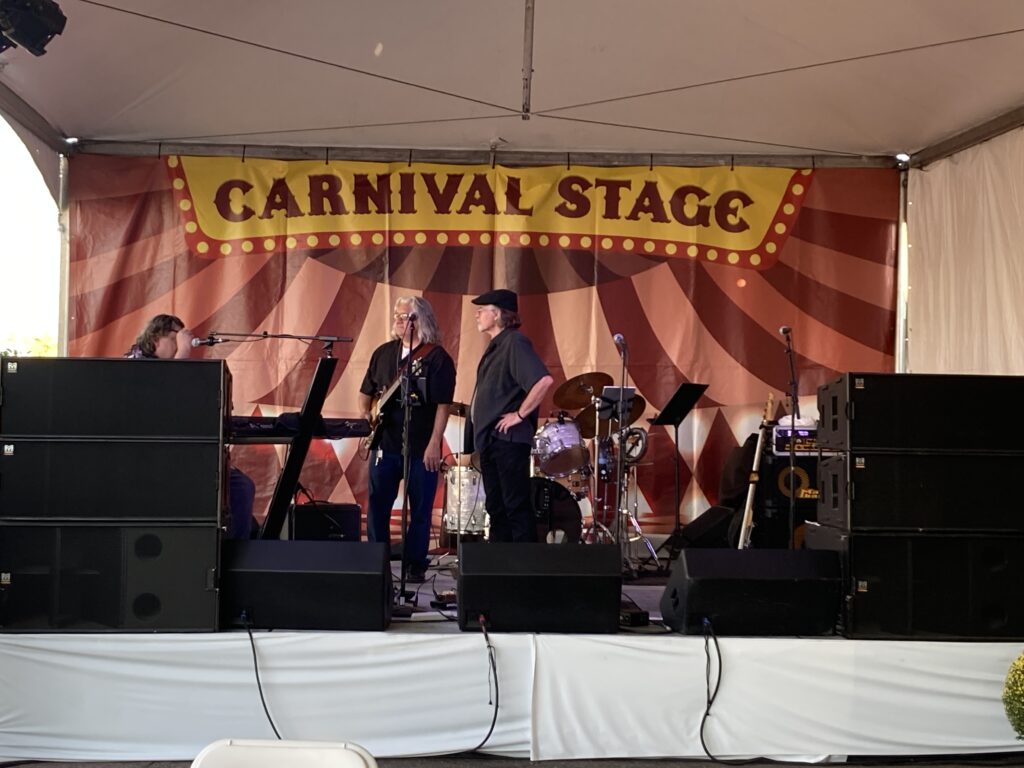
The poor keyboard player was buried in the behind the speaker. I was told the the speakers wouldn’t move, and I’ll need to figure out how to work around them. In a compromise, if I figured out how to do my show with the speakers onstage, they would give me some benches up front and take out the front two tables.
To my surprise, this is what I walked into this morning:
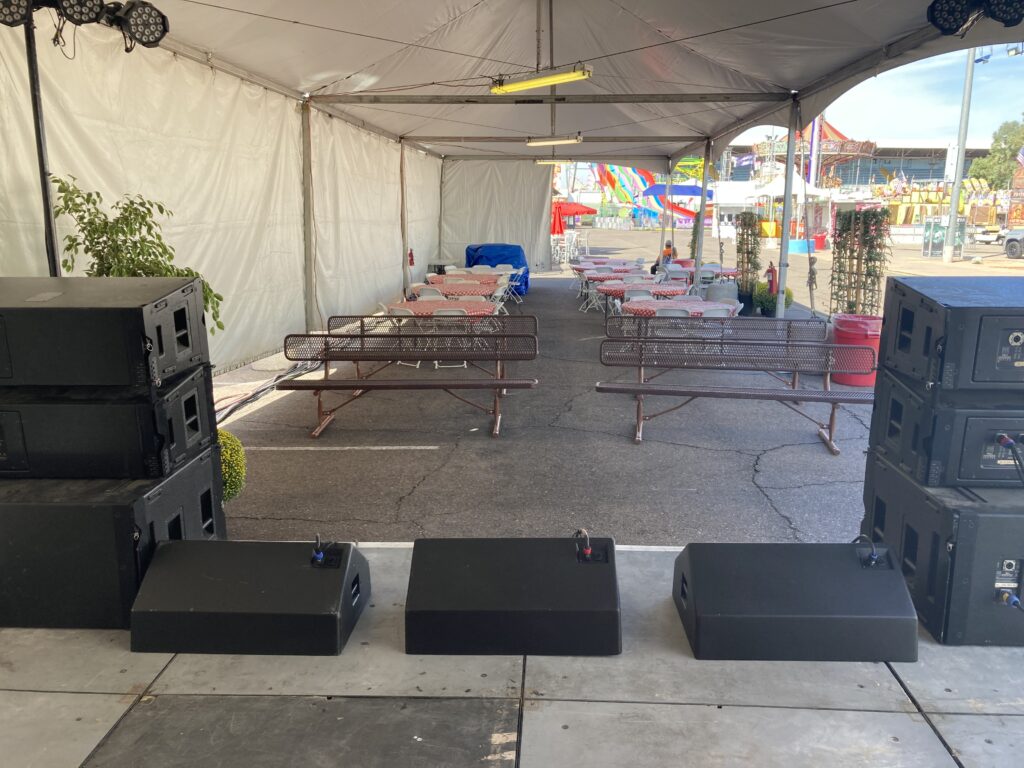
The benches made a world of difference! It gives me a place for my anchor crowd to sit. Once I have that group, I can win over the people with their backs to me at the tables…or I can walk those people as they’ll realize that sitting and chatting at the tables isn’t easy during my show. Once I walk the people that don’t want to watch my show, I can fill the space with people who do.
I’m hoping that people will see that I was right about the benches and maybe think my idea with moving the speakers (somehow) has some merit. I’ll revisit that conversation with production later in the week.
-Louie
Some Stages…
Sometimes you get to a gig and you realize you are going to work. When I got to this show to load in and saw the stage, I knew it was going to be a long run! Here’s the view of the stage from the front:
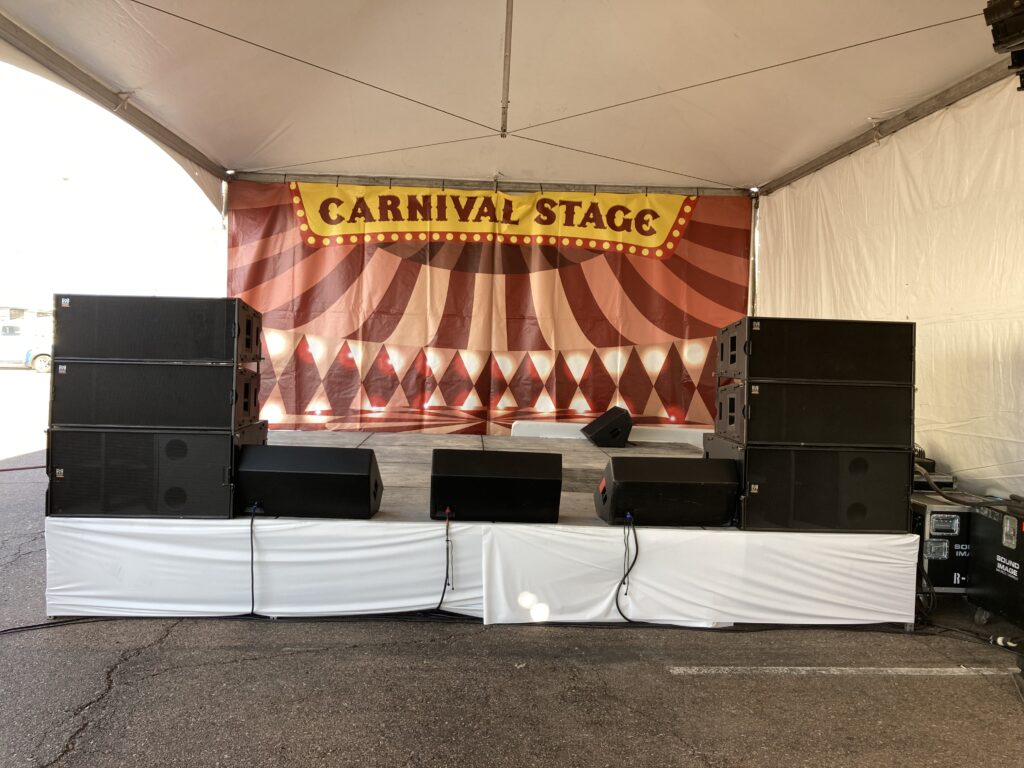
The stage is probably 12 feet wide and 16 feet deep. Then about 7 or 8 feet of the front of the stage is taken up by the speakers. Then the monitors make it impossible to play close to the edge of the stage for maximum visibility. The monitors will force me to play back, and the problem with that is that is the now the tall speakers become visual obstructions for people trying to watch the show if they aren’t seated in the center of the audience.
Now let’s flip the view around and look at the audience from the stage:
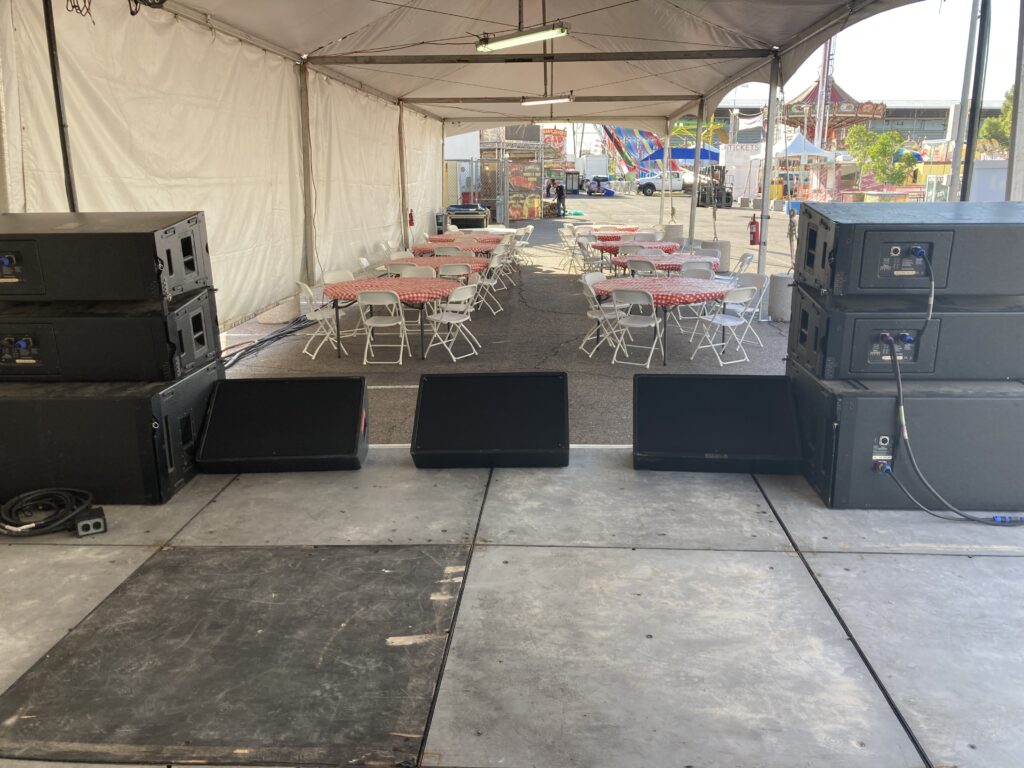
The audience is seated at round tables. That’s horrible for a show. You’ll notice that the chairs closest to the stage actually are facing away the from the stage. So the people with the best seats have their backs to me!
Some gigs I feel like my show is being set up to fail. My plan is to ask for more chairs to fill the front, then either ask for the speakers to be moved to the back of the stage, or do the show on the ground in front of the speakers. It’s going to piss off the sound guy, but it’s really the only option with what they’ve given me.
-Louie
Invisible Deck Plus…
In the past I’ve played with using an invisible deck in my show. The issue I have with it, is that it’s a pretty standard trick. I want to layer it with having something more than just an upside down card. In the past I’ve come up with a method where you can have more than one card picked (no force) and they are all upside down. In my show right now I’m using a variation on Vernet Magic’s 52 B’wave.
The 52 B’wave effect is the named card is upside down, has a different colored back and all of the other cards are blank. I really like this effect, and I think a booker that has seen the invisible deck will be able to tell the difference. What I don’t like about it is that there is a force of the color of the card.
I was kicking around ideas for it, and I think I have come up with a method that I like better than Vernet’s 52 B’wave. Here’s how the effect will play, you show a deck of cards and hold half in each hand. The audience chooses a half to eliminate (no forces are used in this) and you put them on the table. You then split the remaining cards in and half chosen to eliminate and repeat this till you have one card. The elimination process happens with the faces of the cards to the audience. You then reach into your pocket and remove a deck of cards. Inside that deck is one face up card, it matches the one selected by the audience. The card is not only the only card face up, but it has a different colored back, and the rest of the deck is blank! Not that I would do this, but at the end of the trick, the deck is ungimmicked and could be examined.
OK, for method it’s a combination of a gimmick, and sleight of hand. I haven’t tried this yet, but I’ll going to give it a go during my preshow at the fair tomorrow!
-Louie
Thayer Cage…
I just added a new cage to my vanishing birdcage collection.
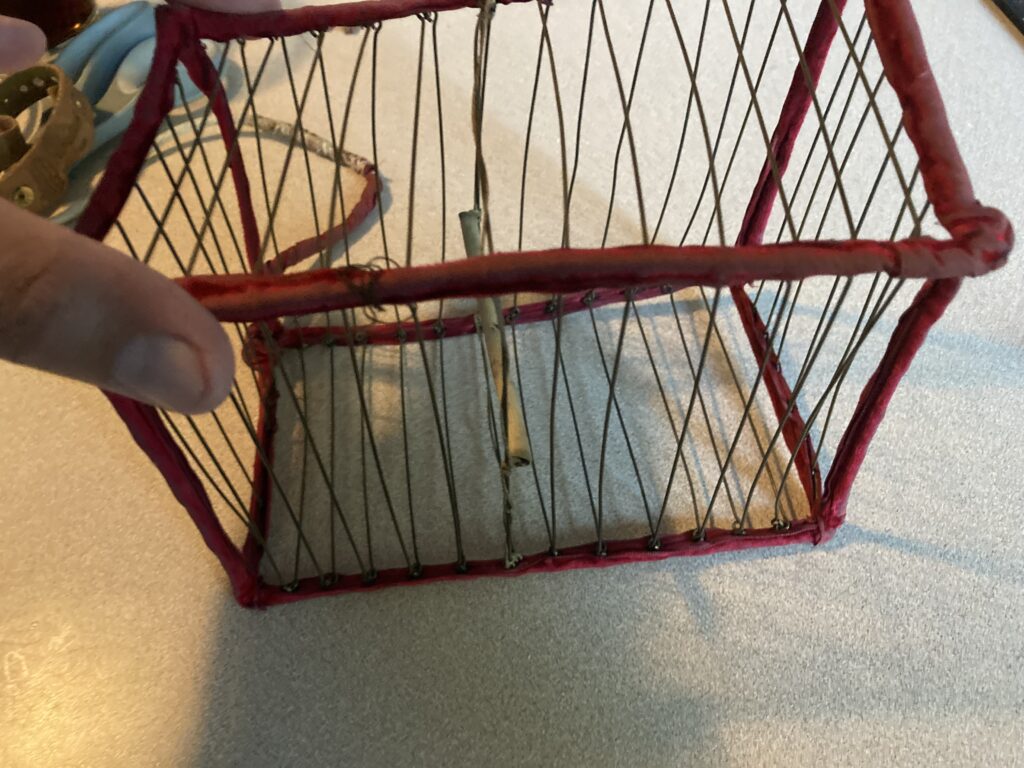
This is a Thayer Vanishing Birdcage and is the non-rigid style cage. For some reason, I thought that Abbotts was the only one that made a non-rigid vanishing birdcage. I don’t know who made them first, however based on the timelines of the two companies, I think Thayer made them before Abbotts, however someone could have made them before both.
This cage is a bridge between the older metal rigid cages and the semi rigid cages, like the Lindhurst cage. This is rectangular and has the fixed perch, where the abbots which I think came after was square and eliminated the fixed perch. I think then the Lindurst style cage grew from the Abbott’s cage.
Another neat thing about the Thayer vanishing birdcage is how the pull is connected to the cage:
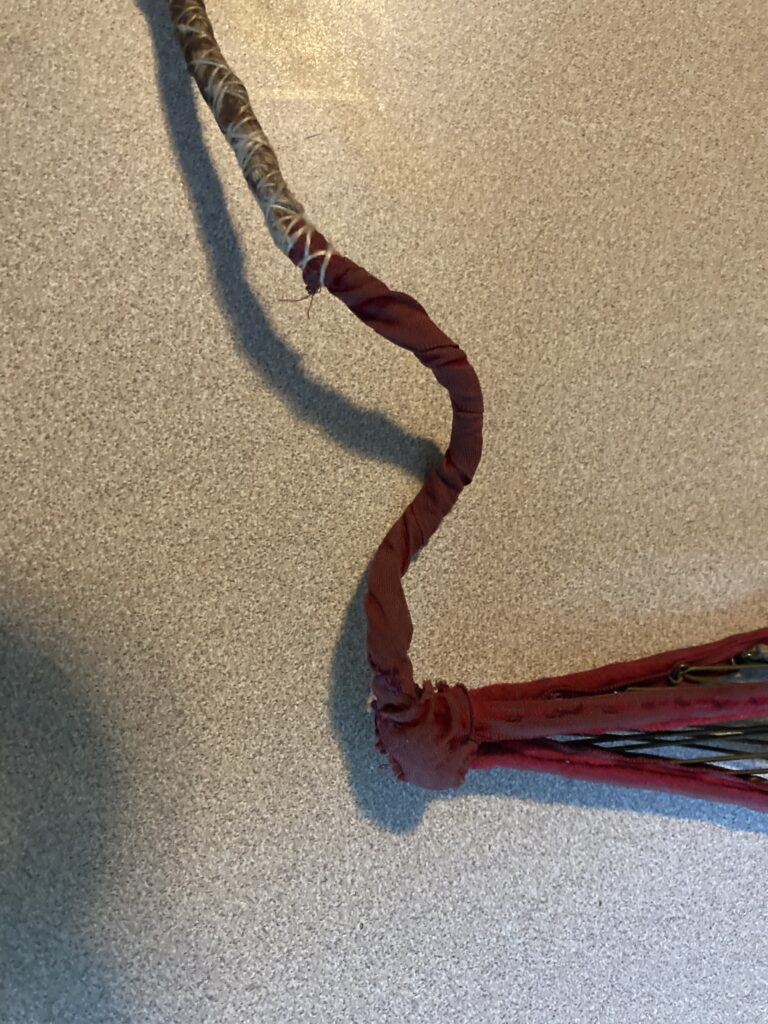
It’s permanently attached to the cage, and not clipped on. The red ribbon extends down the cage onto the pull. This in theory smooths out the cage going up the sleeve and eliminates some possible snag points. Having a clip like a modern cage adds places for the cage to snag.
I’m glad to add this to my collection, as I think it’s a missing link from the older style cage to the more modern cages.

